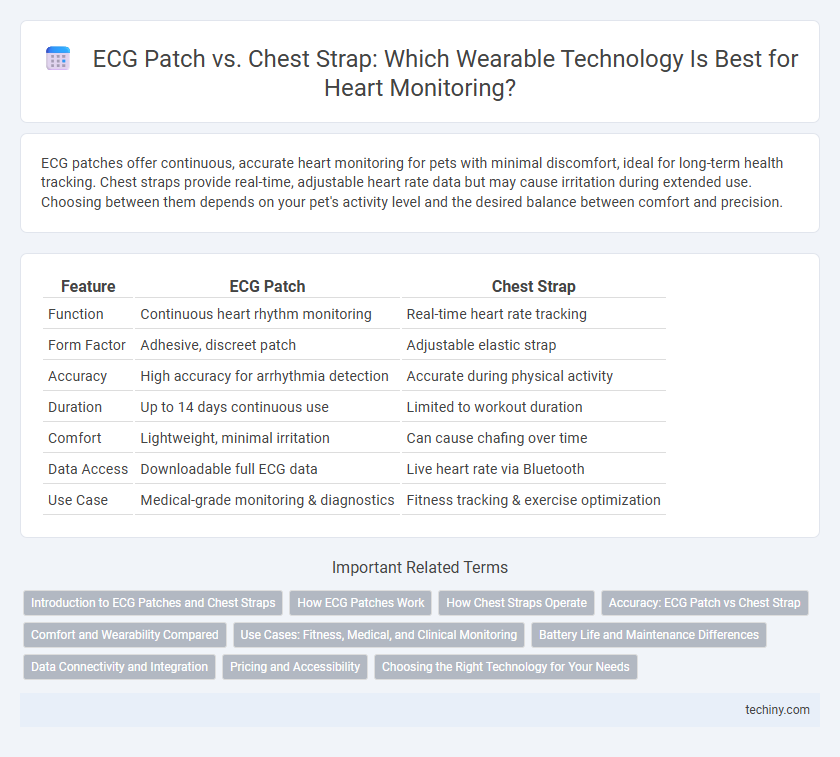ECG patches offer continuous, accurate heart monitoring for pets with minimal discomfort, ideal for long-term health tracking. Chest straps provide real-time, adjustable heart rate data but may cause irritation during extended use. Choosing between them depends on your pet's activity level and the desired balance between comfort and precision.
Table of Comparison
| Feature | ECG Patch | Chest Strap |
|---|---|---|
| Function | Continuous heart rhythm monitoring | Real-time heart rate tracking |
| Form Factor | Adhesive, discreet patch | Adjustable elastic strap |
| Accuracy | High accuracy for arrhythmia detection | Accurate during physical activity |
| Duration | Up to 14 days continuous use | Limited to workout duration |
| Comfort | Lightweight, minimal irritation | Can cause chafing over time |
| Data Access | Downloadable full ECG data | Live heart rate via Bluetooth |
| Use Case | Medical-grade monitoring & diagnostics | Fitness tracking & exercise optimization |
Introduction to ECG Patches and Chest Straps
ECG patches are compact, adhesive devices designed for continuous heart rhythm monitoring, providing detailed electrocardiographic data with minimal user interference. Chest straps use flexible bands embedded with sensors to measure heart rate accuracy, commonly favored for real-time fitness tracking during physical activity. Both technologies offer distinct advantages in wearable heart monitoring, with ECG patches excelling in clinical-grade data collection and chest straps in comfort and dynamic response.
How ECG Patches Work
ECG patches use adhesive sensors to continuously monitor the heart's electrical activity by detecting electrical signals generated by cardiac muscle contractions. These patches transmit real-time heart rate and rhythm data to connected devices via Bluetooth, enabling early detection of arrhythmias and other cardiac abnormalities. Unlike chest straps that primarily measure heart rate through optical sensors, ECG patches provide detailed cardiac electrophysiology for precise health monitoring.
How Chest Straps Operate
Chest straps operate by using embedded electrodes that directly detect the heart's electrical signals, providing highly accurate ECG data in real time. Unlike ECG patches, which adhere to the skin and capture localized heart activity, chest straps wrap around the torso to ensure stable contact and continuous monitoring during intense physical activities. Their tight fit minimizes motion artifacts, making them ideal for athletes seeking precise heart rate and rhythm tracking.
Accuracy: ECG Patch vs Chest Strap
ECG patches offer superior accuracy in heart rate monitoring by directly measuring electrical signals from the heart, providing precise arrhythmia detection and detailed cardiac data. Chest straps use electrodes to capture electrical impulses but are more prone to motion artifacts and interference, which can compromise real-time accuracy during intense physical activity. Studies show ECG patches have higher sensitivity and specificity in detecting cardiac abnormalities compared to chest straps, making them the preferred choice for clinical and long-term monitoring.
Comfort and Wearability Compared
ECG patches offer superior comfort and wearability compared to traditional chest straps due to their slim, adhesive design that conforms closely to the skin without restricting movement. Chest straps, while effective for continuous heart rate monitoring, can cause discomfort and irritation during prolonged use, especially during intense physical activity. Lightweight and discreet ECG patches provide a more user-friendly option for long-term monitoring with minimal interference in daily activities.
Use Cases: Fitness, Medical, and Clinical Monitoring
ECG patches offer discreet, continuous cardiac monitoring ideal for medical diagnostics and clinical use, providing detailed arrhythmia detection and long-term heart rhythm analysis. Chest straps excel in fitness applications by delivering real-time heart rate data with high accuracy during exercise, favored by athletes and trainers for performance tracking. In clinical settings, ECG patches serve prolonged monitoring without impeding daily activities, while chest straps provide immediate feedback during physical stress tests or rehabilitation sessions.
Battery Life and Maintenance Differences
ECG patches typically offer longer battery life, ranging from several days to weeks, due to their low-power sensors and optimized energy consumption, while chest straps generally require daily charging after intense use during workouts. Maintenance of ECG patches is minimal, involving simple skin adhesion replacement and occasional cleaning, whereas chest straps demand regular washing to remove sweat and prevent odor accumulation. Battery longevity and ease of upkeep make ECG patches more convenient for long-term heart monitoring compared to chest straps.
Data Connectivity and Integration
ECG patches offer seamless Bluetooth connectivity allowing continuous heart rate monitoring and real-time data synchronization with smartphones and health apps, enhancing remote patient management. Chest straps typically use ANT+ or Bluetooth protocols to transmit precise heart rate data to fitness devices and smartwatches, favoring integration with exercise tracking platforms. Both devices support cloud-based health analytics, but ECG patches provide superior integration with medical record systems for comprehensive cardiac monitoring.
Pricing and Accessibility
ECG patches typically cost between $100 and $300, offering advanced cardiac monitoring with easy application, while chest straps range from $50 to $150, providing affordable and widely accessible heart rate tracking mainly suited for fitness enthusiasts. The ECG patch's single-use design may increase long-term costs despite its precise data, whereas chest straps are reusable and compatible with a variety of devices, enhancing accessibility for users on a budget. Consumers seeking continuous, accurate ECG data may invest more initially, but those prioritizing cost-effectiveness and ease of purchase often prefer chest straps.
Choosing the Right Technology for Your Needs
ECG patches provide continuous heart rhythm monitoring with medical-grade accuracy, ideal for detecting arrhythmias and long-term cardiac health tracking. Chest straps offer real-time, high-precision heart rate data optimized for active users and fitness enthusiasts during workouts or sports performance. Selecting between these wearables depends on whether you prioritize detailed cardiac diagnostics or dynamic, exercise-focused heart rate monitoring.
ECG Patch vs Chest Strap Infographic

 techiny.com
techiny.com